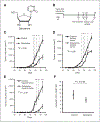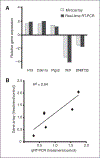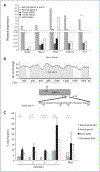DNA methyltransferase inhibitor, zebularine, delays tumor growth and induces apoptosis in a genetically engineered mouse model of breast cancer
- PMID: 22203734
- PMCID: PMC7457145
- DOI: 10.1158/1535-7163.MCT-11-0458
DNA methyltransferase inhibitor, zebularine, delays tumor growth and induces apoptosis in a genetically engineered mouse model of breast cancer
Abstract
Zebularine is a novel potent inhibitor of both cytidine deaminase and DNA methylation. We examined the effect of zebularine on mammary tumor growth in genetically engineered MMTV-PyMT transgenic mice that develop mammary tumors at 60 days of age with 100% penetrance. The MMTV-PyMT transgenic mice were randomized at 46 days of age into control (n = 25) and zebularine (n = 25) treatment groups and monitored for parameters of tumor growth. Zebularine was administered at 5 mg/mL in drinking water. We observed a significant delay in the growth of mammary tumors in zebularine-treated mice with a statistically significant reduction (P = 0.0135) in total tumor burden at 94 days of age when the mice were sacrificed. After 48 days of zebularine treatment, the tumors were predominantly necrotic compared with untreated animals. In addition, a high apoptotic index by terminal deoxynucleotidyl transferase-mediated dUTP nick end labeling assay was observed as early as 13 days following treatment. Immunoblot analysis showed depletion of DNMT1 and partial depletion of DNMT3b after zebularine treatment. Microarray analyses of global gene expression identified upregulation of twelve methylation-regulated genes as well as a set of candidate cancer genes that participate in cell growth and apoptosis. In summary, zebularine inhibits the growth of spontaneous mammary tumors and causes early onset of tumor cell necrosis and apoptosis in a genetically engineered mouse model of breast cancer. Defining the parameters of zebularine-mediated tumor inhibition may advance the future development of DNA methyltransferase inhibitors as an effective cancer treatment.
Conflict of interest statement
Disclosure of Potential Conflicts of Interest
No potential conflicts of interest were disclosed.
Figures





Similar articles
-
Zebularine enhances apoptosis of human osteosarcoma cells by suppressing methylation of ARHI.Cancer Sci. 2016 Dec;107(12):1851-1857. doi: 10.1111/cas.13088. Epub 2016 Dec 19. Cancer Sci. 2016. Retraction in: Cancer Sci. 2024 Dec;115(12):4080. doi: 10.1111/cas.16346. PMID: 27685841 Free PMC article. Retracted.
-
Effects of a novel DNA methyltransferase inhibitor zebularine on human breast cancer cells.Breast Cancer Res Treat. 2010 Apr;120(3):581-92. doi: 10.1007/s10549-009-0420-3. Epub 2009 May 21. Breast Cancer Res Treat. 2010. PMID: 19459041 Free PMC article.
-
DNA methyltransferase inhibitor zebularine induces human cholangiocarcinoma cell death through alteration of DNA methylation status.PLoS One. 2015 Mar 23;10(3):e0120545. doi: 10.1371/journal.pone.0120545. eCollection 2015. PLoS One. 2015. PMID: 25799509 Free PMC article.
-
Insights from transgenic mouse models of PyMT-induced breast cancer: recapitulating human breast cancer progression in vivo.Oncogene. 2021 Jan;40(3):475-491. doi: 10.1038/s41388-020-01560-0. Epub 2020 Nov 24. Oncogene. 2021. PMID: 33235291 Free PMC article. Review.
-
Zebularine: a unique molecule for an epigenetically based strategy in cancer chemotherapy.Ann N Y Acad Sci. 2005 Nov;1058:246-54. doi: 10.1196/annals.1359.037. Ann N Y Acad Sci. 2005. PMID: 16394141 Review.
Cited by
-
Zebularine-induced apoptosis in Calu-6 lung cancer cells is influenced by ROS and GSH level changes.Tumour Biol. 2013 Apr;34(2):1145-53. doi: 10.1007/s13277-013-0656-8. Epub 2013 Jan 22. Tumour Biol. 2013. PMID: 23338718
-
Reversibility of membrane N-glycome of HeLa cells upon treatment with epigenetic inhibitors.PLoS One. 2013;8(1):e54672. doi: 10.1371/journal.pone.0054672. Epub 2013 Jan 15. PLoS One. 2013. PMID: 23336012 Free PMC article.
-
DNA methylation dynamics in health and disease.Nat Struct Mol Biol. 2013 Mar;20(3):274-81. doi: 10.1038/nsmb.2518. Nat Struct Mol Biol. 2013. PMID: 23463312 Review.
-
DNA methyltransferase 1 inhibits microRNA-497 and elevates GPRC5A expression to promote chemotherapy resistance and metastasis in breast cancer.Cancer Cell Int. 2022 Mar 7;22(1):112. doi: 10.1186/s12935-022-02466-5. Cancer Cell Int. 2022. PMID: 35255904 Free PMC article.
-
DNA Methylation Patterns in T Cells of Naïve and Influenza A Virus-Infected Mice Developmentally Exposed to an Aryl Hydrocarbon Receptor Ligand.Environ Health Perspect. 2021 Jan;129(1):17007. doi: 10.1289/EHP7699. Epub 2021 Jan 15. Environ Health Perspect. 2021. PMID: 33449811 Free PMC article.
References
-
- Jones PA, Taylor SM. Cellular differentiation, cytidine analogs and DNA methylation. Cell 1980;20:85–93. - PubMed
-
- Sorm F, Vesely J. Effect of 5-aza-2′-deoxycytidine against leukemic and hemopoietic tissues in AKR mice. Neoplasma 1968;15:339–43. - PubMed
-
- Beisler JA. Isolation, characterization, and properties of a labile hydrolysis product of the antitumor nucleoside, 5-azacytidine. J Med Chem 1978;21:204–8. - PubMed
-
- Yoo CB, Cheng JC, Jones PA. Zebularine: a new drug for epigenetic therapy. Biochem Soc Trans 2004;32:910–2. - PubMed
Publication types
MeSH terms
Substances
Grants and funding
LinkOut - more resources
Full Text Sources
Other Literature Sources

